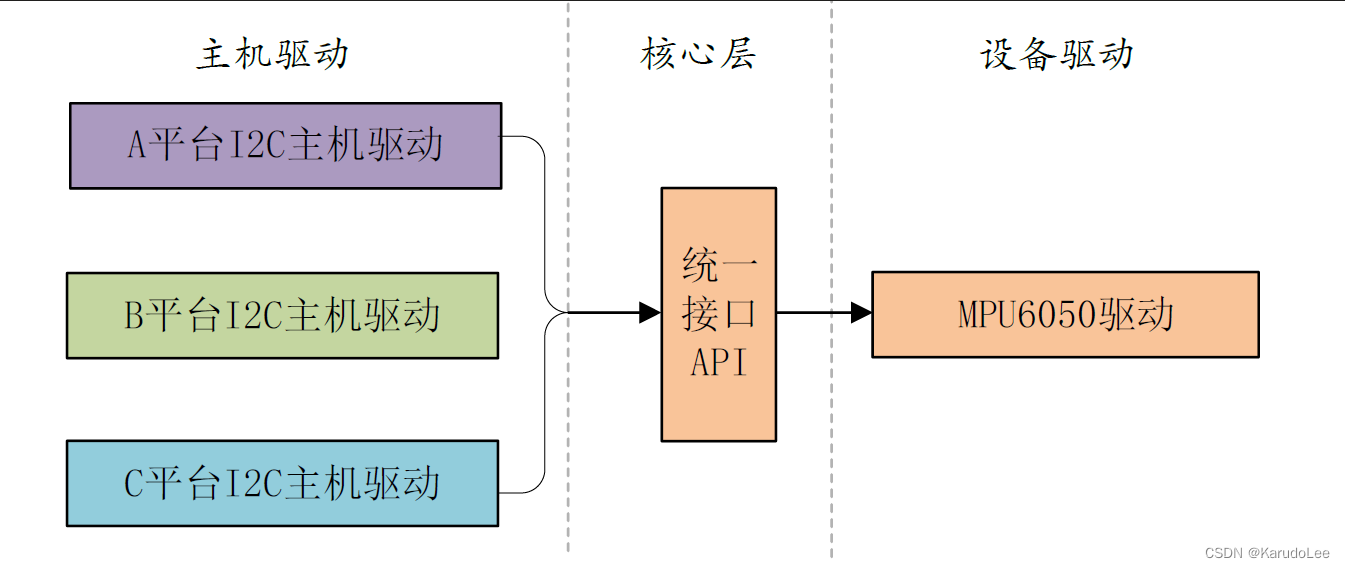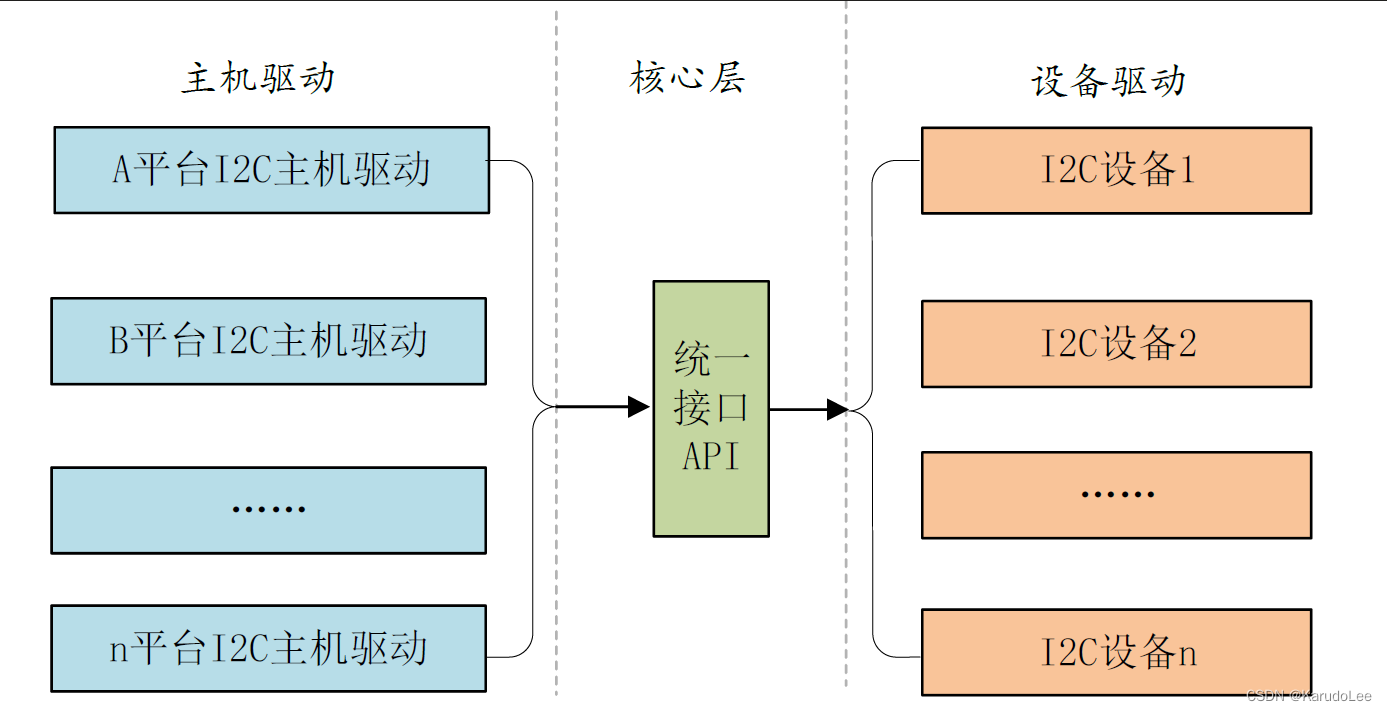目录
一、Linux驱动的分离
对于Linux这种庞大而复杂的系统,需要非常注重代码的重用性,否则Linux内核中将会存在大量无意义的重复代码。假设现在有三个平台A、B和C,该三个平台都有MPU6050这个I2C接口的六轴传感器,如果按照写裸机I2C驱动的思路,每个平台都有一个MPU6050的驱动,因此编写出来的最简单的驱动框架如图:

如果再来几个I2C设备,比如AT24C02、FT5206(电容触摸屏)等,按照上图的写法,那么设备端的驱动将再重复编写好几次。显然在Linux驱动程序中这种写法是不推荐的,最好的做法就是每个平台的I2C控制器都提供一个统一的接口(主机驱动),每个设备也只提供一个驱动程序(设备驱动),每个设备通过统一的I2C接口驱动来访问,这样就可以大大简化驱动文件:

此时如果再来几个I2C设备,比如AT24C02、FT5206(电容触摸屏)等,那么就是:

这便是驱动的分隔,即将主机驱动和设备驱动分隔开来,比如I2C、SPI等等都会采用驱动分隔的方式来简化驱动的开发。
在实际的驱动开发中,主机控制器驱动一般由半导体厂家编写好,而设备驱动一般也由设备器件的厂家编写好,我们只需要提供设备信息即可。
驱动只负责驱动,设备只负责设备,将两者进行匹配即可(相当于将设备信息从设备驱动中剥离开来,驱动使用标准方法去获取到设备信息,比如从设备树中获取到设备信息,然后根据获取到的设备信息来初始化设备)——即Linux中的总线(bus)、驱动(driver)和设备(device)模型:

当向系统注册一个驱动的时候,总线就会在右侧的设备中查找,看看有没有与之匹配的设备,如果有的话就将两者联系起来;同样的,当向系统中注册一个设备的时候,总线也会在左侧的驱动中查找看有没有与之匹配的设备,有的话也联系起来。Linux内核中大量的驱动程序都采用总线、驱动和设备模式,platform驱动就是这一思想下的产物。
二、Linux驱动的分层
网络有7层模型,不同的层负责不同的内容。同样的, Linux下的驱动往往也是分层的,分层的目的也是为了在不同的层处理不同的内容。
比如input子系统(经常所使用到)负责管理所有跟输入有关的驱动,包括键盘、鼠标、触摸等,最底层的就是设备原始驱动,负责获取输入设备的原始值,获取到的输入事件上报给input核心层。 input核心层会处理各种IO模型,并且提供file_operations操作集合。在编写输入设备驱动的时候只需要处理好输入事件的上报即可,至于如何处理这些上报的输入事件那是上层去考虑的。
三、platform平台驱动模型简介
platform驱动框架分为总线、设备和驱动,其中总线是Linux内核提供的,编写驱动时只需要关注设备(platform_device)和驱动(platform_driver)的具体实现即可。在无设备树的Linux内核下,需要分别编写并注册platform_device和platform_driver;在使用设备树时,设备的描述被放到了设备树中,因此platform_device不用编写,只需要实现platform_driver即可。
3.1 platform_driver结构体
platform_driver结构体表示platform驱动,此结构体定义在文件include/linux/platform_device.h中:
struct platform_driver {
int (*probe)(struct platform_device *);
int (*remove)(struct platform_device *);
void (*shutdown)(struct platform_device *);
int (*suspend)(struct platform_device *, pm_message_t state);
int (*resume)(struct platform_device *);
struct device_driver driver;
const struct platform_device_id *id_table;
bool prevent_deferred_probe;
};
probe函数:当驱动与设备匹配成功以后probe函数就会执行。
driver成员:device_driver结构体变量,Linux内核里大量使用面向对象的思维,device_driver相当于基类,提供了最基础的驱动框架。plaform_driver继承了这个基类,然后在此基础上又添加了一些特有的成员变量。
id_table:platform总线匹配驱动和设备的时候采用的一种方法, id_table是个表 (数组),每个元素的类型为platform_device_id:
struct platform_device_id {
char name[PLATFORM_NAME_SIZE];
kernel_ulong_t driver_data;
};
3.2 device_driver结构体
device_driver结构体定义在include/linux/device.h:
struct device_driver {
const char *name;
struct bus_type *bus;
struct module *owner;
const char *mod_name; /* used for built-in modules */
bool suppress_bind_attrs; /* disables bind/unbind via sysfs */
const struct of_device_id *of_match_table;
const struct acpi_device_id *acpi_match_table;
int (*probe) (struct device *dev);
int (*remove) (struct device *dev);
void (*shutdown) (struct device *dev);
int (*suspend) (struct device *dev, pm_message_t state);
int (*resume) (struct device *dev);
const struct attribute_group **groups;
const struct dev_pm_ops *pm;
struct driver_private *p;
};
of_match_table:采用设备树时驱动所使用的匹配表(数组),每个匹配项都为of_device_id结构体类型,此结构体定义在文件include/linux/mod_devicetable.h中,内容如下:
struct of_device_id {
char name[32];
char type[32];
char compatible[128];
const void *data;
};
compatible:对于设备树而言,通过设备节点的compatible属性值和of_match_table中每个项目的compatible成员变量进行比较,如果有相等的就表示设备和此驱动匹配成功。
注意,of_device_id表最后一个匹配项必须是空的!
3.3 platform驱动API函数
在编写platform驱动时,首先定义一个platform_driver结构体变量,然后实现结构体中的各个成员变量(重点是实现匹配方法以及probe函数)。当驱动和设备匹配成功以后probe函数就会执行,具体的驱动程序在probe函数里面编写,比如字符设备驱动等等。
当我们定义并初始化好platform_driver结构体变量以后,需要在驱动入口函数里面调用platform_driver_register函数向Linux内核注册一个platform驱动:
int platform_driver_register (struct platform_driver *driver) driver:要注册的platform驱动。
返回值:负数即失败;0即成功。
驱动卸载函数中通过platform_driver_unregister函数卸载platform驱动:
void platform_driver_unregister(struct platform_driver *drv)drv:要卸载的platform驱动。
返回值:无。
四、驱动代码
platform驱动框架:
struct xxx_dev{
struct cdev cdev;
/* 设备结构体其他具体内容 */
};
struct xxx_dev xxxdev; /* 定义个设备结构体变量 */
static int xxx_open(struct inode *inode, struct file *filp)
{
/* 函数具体内容 */
return 0;
}
static ssize_t xxx_write(struct file *filp, const char __user *buf, size_t cnt, loff_t *offt)
{
/* 函数具体内容 */
return 0;
}
/*
* 字符设备驱动操作集
*/
static struct file_operations xxx_fops = {
.owner = THIS_MODULE,
.open = xxx_open,
.write = xxx_write,
};
/*
* platform驱动的probe函数
* 驱动与设备匹配成功以后此函数就会执行
*/
static int xxx_probe(struct platform_device *dev)
{
......
cdev_init(&xxxdev.cdev, &xxx_fops); /* 注册字符设备驱动 */
/* 函数具体内容 */
return 0;
}
static int xxx_remove(struct platform_device *dev)
{
......
cdev_del(&xxxdev.cdev);/* 删除cdev */
/* 函数具体内容 */
return 0;
}
/* 匹配列表 */
static const struct of_device_id xxx_of_match[] = {
{ .compatible = "xxx-gpio" },
{ /* Sentinel */ }
};
/*
* platform平台驱动结构体
*/
static struct platform_driver xxx_driver = {
.driver = {
.name = "xxx",
.of_match_table = xxx_of_match,
},
.probe = xxx_probe,
.remove = xxx_remove,
};
/* 驱动模块加载 */
static int __init xxxdriver_init(void)
{
return platform_driver_register(&xxx_driver);
}
/* 驱动模块卸载 */
static void __exit xxxdriver_exit(void)
{
platform_driver_unregister(&xxx_driver);
}
module_init(xxxdriver_init);
module_exit(xxxdriver_exit);
MODULE_LICENSE("GPL");